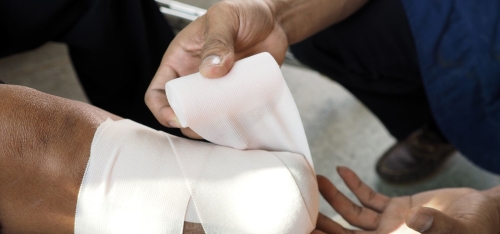Simple Steps, Regular Checks: Lessons from Healthy Life Clinic Diabetes Protocol



- 50% of hospital amputations caused by diabetes-related complications
- 1 in 10 Sri Lankan adults suffer from diabetes
- Small lifestyle changes can have the biggest impact
A few simple and regular steps can make all the difference when it comes to preventative care and ensuring a decent quality of life for those afflicted by diabetes. Given that 1 in 10 Sri Lankan adults – or 1.6 million out of a 20.1 million population – suffer from diabetes, and that as much as 50% of all amputations that take place in hospitals today are as a result of diabetes-related complications, it is vital that patients and caregivers not only learn, but also seriously commit to a rigid meal plan, daily exercise, and a thorough self-care regimen.
What can start as a tiny blister on one or both feet can quickly be exacerbated by a lack of self-care, leading to severely-infected foot ulcers and tissue loss, and if unchecked – ultimately lead to amputation in a majority of cases or a full-body infection known as sepsis.
However, according to Healthy Life Clinic Director and Chief Consultant Diabetologist, these dire consequences can be easily prevented with a simple, daily routine.
“Most people are unaware that diabetic feet can be easily prevented through a simple, systematic regime of careful skincare, frequent inspection of feet and use of special footwear as suggested by medical professionals. Amputations are often caused because patients aren’t educated thoroughly on their condition or are lax with their self-care regimes. This not only leads to longer hospital stays but also higher expenditure on the patient’s part. The entire experience can be a real and difficult mental and emotional burden for patients and their loved ones, so we cannot stress this enough – if you have diabetes, you need to understand your condition, and stay committed to your self-care. Doing so can make all the difference to your quality of life.”
Foot ulcers are generally the result of one or more complications caused due to high blood sugar. These may include;
- Neuropathy – nerve damage resulting in the loss of feeling in lower limbs, and a tendency towards feet deformities such as bunions or hammertoes. Usually checked by a monofilament or sensitometer.
- Ischemia – a result of clogged arteries bringing about thin, hairless skin, white or bluish nail beds and dusky red or purple feet. Detected by a foot pulse test called an Ankle Brachial Index (ABI).
- Swelling – a predisposition to foot ulcers, swelling can also slow down healing capabilities.
- Corns and calluses – Deep focused lesions of hardened skin or an unusually thickened areas of skin on soles, they are cause for immediate concern and medication.
- Skin breakdown and infection – With enough pressure, skin on feet may break open, leaving feet exposed to a serious infection that may even reach the bone underneath.
- Necrosis – Black, dead tissue due to lack of blood supply, reaching a critical stage called Gangrene.
Another simple factor that has a major influence on patient outcomes and well-being is the frequency of contact and quality of relationship with their general practitioner. Regular monitoring of a patient’s condition, combined with the therapeutic benefits of having a regular, impartial, and informed discussion about their condition can be of tremendous value in helping patients stay committed to the positive lifestyle changes they have made. Healthy Life Clinic’s Smart D programme is a unique example of this principle in practice, providing patients with a year-long targeted diabetic healthcare plan that includes a simple but comprehensive healthcare regimen, pre-booked doctor consultations, regular laboratory tests, and practical diabetic lifestyle and self-care coaching from a panel of experienced medical professionals. Additionally, the clinic also offers footwear made especially to suit the unique needs of diabetic patients.
Selecting the perfect pair
“A good, consistent relationship with your doctor is key to curbing and controlling the critical effects of any disease, especially life-long conditions such as high blood sugar. This way the patient is always in control of their condition by being armed with a rich knowledge base and a clear understanding of what to do and what to avoid in their daily lives. From optimal meal plans to all the practical measures needed to avoid foot ulcers, it is ultimately the patient who must manage their condition for life, but that does not mean it is a life sentence. With the right help, a clear plan and resolute commitment, the obstacles that diabetes creates can easily be overcome,” Dr. Periasamy added.
Given the sensitivity of diabetic feet, patients are often recommended to use covered, supported footwear with soft, contoured insoles to match foot arches. These shoes should be wide and not tight-fitting, with highly adjustable settings like velcro or lace. Heels which add an unwanted amount of pressure to certain areas of the foot are to be avoided as much as possible.
Leather or suede is preferred over tight plastic shoes, as they tend to gather moisture in skin creases, creating a breeding ground for bacteria. Avoiding being barefoot and always choosing sandals over flip flops are always a great idea. Footwear made especially for diabetic patients is a good bet to cover all these requirements, and are usually available at certain clinics.
But this is not all, it is vital that the patient checks their feet every day for a sign of injury, changes in temperature and keep them neat, clean and dry; avoiding skincare creams especially in between toes. If minor injuries do occur, it is recommended that they are treated right away with soap, water, and antibiotic cream.
Listen when your feet are ‘talking’
As we listen to our body’s needs of hunger, thirst, pain or sleep, diabetic patients should pay more attention to the signals their feet send out. This can range from acute tingling sensations of pins and needles or a certain numbness or heaviness when walking to stabbing pains or persistent restlessness in the feet or legs. When a patient feels one or more of these sensations on their feet, then it is time to visit a doctor as they are tell-tale signs of an impending diabetic foot.
“The main takeaway is that if you have diabetes, it is vital to take the signs your body gives you seriously. It is your body’s way of asking for help and so you owe it to yourself to listen,”
“Diabetes – as with any lifelong medical condition – is easier to control once the patient is fully aware of the full scope of what it is and how it works. This is vital when it comes to avoiding if not mitigating dangerous complications of diabetic feet. Access to proper wound care, special diabetes shoes or sandals, regular lab tests, and the right medicine forms the winning combination for combatting diabetic foot conditions. Patients should be armed with the mantra that ‘no wound or alarm is small enough to avoid a doctor’s visit.”
This article can be viewed online at Ada Derana, Lanka Business News and Ceylon Business Reporter






